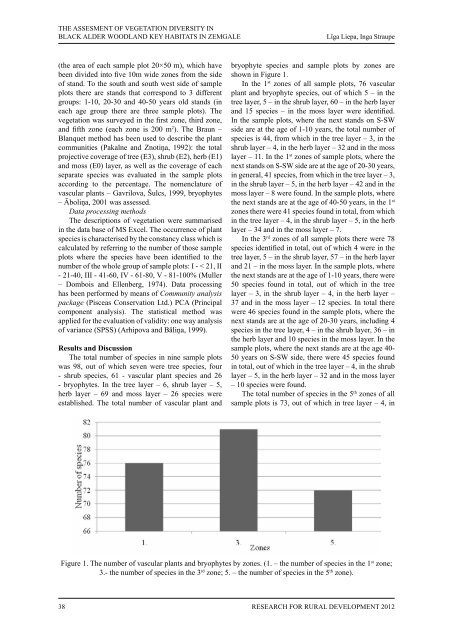RESEARCH FOR
RESEARCH FOR
RESEARCH FOR
You also want an ePaper? Increase the reach of your titles
YUMPU automatically turns print PDFs into web optimized ePapers that Google loves.
THE ASSESMENT OF VEGETATION DIVERSITY IN<br />
BLACK ALDER WOODLAND KEY HABITATS IN ZEMGALE<br />
(the area of each sample plot 20×50 m), which have<br />
been divided into five 10m wide zones from the side<br />
of stand. To the south and south west side of sample<br />
plots there are stands that correspond to 3 different<br />
groups: 1-10, 20-30 and 40-50 years old stands (in<br />
each age group there are three sample plots). The<br />
vegetation was surveyed in the first zone, third zone,<br />
and fifth zone (each zone is 200 m 2 ). The Braun –<br />
Blanquet method has been used to describe the plant<br />
communities (Pakalne and Znotiņa, 1992): the total<br />
projective coverage of tree (E3), shrub (E2), herb (E1)<br />
and moss (E0) layer, as well as the coverage of each<br />
separate species was evaluated in the sample plots<br />
according to the percentage. The nomenclature of<br />
vascular plants – Gavrilova, Šulcs, 1999, bryophytes<br />
– Āboliņa, 2001 was assessed.<br />
Data processing methods<br />
The descriptions of vegetation were summarised<br />
in the data base of MS Excel. The occurrence of plant<br />
species is characterised by the constancy class which is<br />
calculated by referring to the number of those sample<br />
plots where the species have been identified to the<br />
number of the whole group of sample plots: I - < 21, II<br />
- 21-40, III - 41-60, IV - 61-80, V - 81-100% (Muller<br />
– Dombois and Ellenberg, 1974). Data processing<br />
has been performed by means of Community analysis<br />
package (Pisceas Conservation Ltd.) PCA (Principal<br />
component analysis). The statistical method was<br />
applied for the evaluation of validity: one way analysis<br />
of variance (SPSS) (Arhipova and Bāliņa, 1999).<br />
results and discussion<br />
The total number of species in nine sample plots<br />
was 98, out of which seven were tree species, four<br />
- shrub species, 61 - vascular plant species and 26<br />
- bryophytes. In the tree layer – 6, shrub layer – 5,<br />
herb layer – 69 and moss layer – 26 species were<br />
established. The total number of vascular plant and<br />
Līga Liepa, Inga Straupe<br />
bryophyte species and sample plots by zones are<br />
shown in Figure 1.<br />
In the 1 st zones of all sample plots, 76 vascular<br />
plant and bryophyte species, out of which 5 – in the<br />
tree layer, 5 – in the shrub layer, 60 – in the herb layer<br />
and 15 species – in the moss layer were identified.<br />
In the sample plots, where the next stands on S-SW<br />
side are at the age of 1-10 years, the total number of<br />
species is 44, from which in the tree layer – 3, in the<br />
shrub layer – 4, in the herb layer – 32 and in the moss<br />
layer – 11. In the 1 st zones of sample plots, where the<br />
next stands on S-SW side are at the age of 20-30 years,<br />
in general, 41 species, from which in the tree layer – 3,<br />
in the shrub layer – 5, in the herb layer – 42 and in the<br />
moss layer – 8 were found. In the sample plots, where<br />
the next stands are at the age of 40-50 years, in the 1 st<br />
zones there were 41 species found in total, from which<br />
in the tree layer – 4, in the shrub layer – 5, in the herb<br />
layer – 34 and in the moss layer – 7.<br />
In the 3 rd zones of all sample plots there were 78<br />
species identified in total, out of which 4 were in the<br />
tree layer, 5 – in the shrub layer, 57 – in the herb layer<br />
and 21 – in the moss layer. In the sample plots, where<br />
the next stands are at the age of 1-10 years, there were<br />
50 species found in total, out of which in the tree<br />
layer – 3, in the shrub layer – 4, in the herb layer –<br />
37 and in the moss layer – 12 species. In total there<br />
were 46 species found in the sample plots, where the<br />
next stands are at the age of 20-30 years, including 4<br />
species in the tree layer, 4 – in the shrub layer, 36 – in<br />
the herb layer and 10 species in the moss layer. In the<br />
sample plots, where the next stands are at the age 40-<br />
50 years on S-SW side, there were 45 species found<br />
in total, out of which in the tree layer – 4, in the shrub<br />
layer – 5, in the herb layer – 32 and in the moss layer<br />
– 10 species were found.<br />
The total number of species in the 5 th zones of all<br />
sample plots is 73, out of which in tree layer – 4, in<br />
Figure 1. The number of vascular plants and bryophytes by zones. (1. – the number of species in the 1 st zone;<br />
3.- the number of species in the 3 rd zone; 5. – the number of species in the 5 th zone).<br />
38 ReseaRch foR RuRal Development 2012


